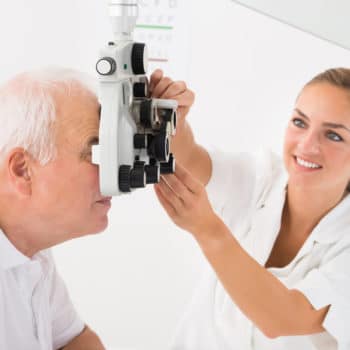Why We Love It
-
$101,260Potential Avg. Salary
-
35.3%Job Growth Rate
-
Growing DemandJob Outlook
-
Good Entry Level SalaryCareer Attribute
Nurse practitioners provide a level of care between a registered nurse and a physician. They perform typical nursing responsibilities like taking vitals, administering medications, and performing injections, but they may also see patients independently, prescribe medications, and order laboratory tests.
Recommended Schools
What is a Nurse Practitioner (NP)?
The following job responsibilities are common for individuals in nurse practitioner roles:
- Perform physicals, take vitals, and collect patient medical histories
- Listen to patient concerns and provide guidance on improving or sustaining health
- Take blood, skin, and urine samples and order laboratory tests of samples
- Diagnose diseases and other disorders, and either prescribe medications or refer patients to physicians for further care
- Administer immunizations and other injections, perform skin biopsies, and stitch injuries
A Day in the Life of a Nurse Practitioner
Nurse practitioners (NPs) are registered nurses that undergo training beyond a bachelor’s degree in order to provide more advanced care to patients. While many physicians are concerned with treatment of diseases and disorders, nurse practitioners are more concerned with disease management and preventative health care. Nurse practitioners commonly specialize in working with a specific group of people, such as diabetics, children, seniors, women of childbearing age, or organ transplant recipients.
NPs perform some traditional nursing tasks as well as tasks more commonly performed by physicians. They often work in private physicians’ offices, unlike RNs who more commonly work in hospitals. When patients arrive for an appointment, the NP collects medical histories, performs physical examinations, and listens to patients’ health concerns. However, the NP also goes a step further, ordering laboratory tests when needed, diagnosing diseases, illnesses, and disorders, and prescribing treatments.
Each state has its own set of regulations that dictate the types of tasks nurse practitioners are allowed to perform. In some states, NPs can prescribe medications, but in others, NPs must work with physicians to prescribe medication. In all states, the nurse practitioner works under the guidance and supervision of a physician. NPs may also focus their work on teaching patients how to manage and prevent disease, teaching diabetics how to control their glucose levels, or teaching teenagers about STDs and prevention.
Typical Work Schedule for Nurse Practitioners
Nurse practitioners typically work full-time following the regular schedule of 40 hours per week. Some may also work on-call or part-time for fewer hours per week. They may also have to work longer hours during emergencies. Similar to other healthcare jobs, you will have to rotate around different work shifts including working in the evenings and weekends. This may be stressful to some people and prevent them from maintaining their life routine. While most nurse practitioners work in physicians’ offices, hospitals, and outpatient care centers, some make house calls to patients’ homes or travel long distances to provide healthcare services in underserved areas which may add longer hours to the working schedule.
Projected Job Growth for Nurse Practitioners
According to the American Association of Nurse Practitioners, there are more than 290,000 nurse practitioners registered in the US with around 30,000 graduating each year. The US Bureau of Labor Statistics indicates that the demand for this job is expected to grow by 48% from 2019 to 2029. This is one of the highest growth rates and much higher than the average expected growth rate for other jobs. This expected growth is mainly attributed to the growing emphasis on preventive care and the aging population. Nurse practitioners play a major role in preventive care by focusing on counseling, health education and guidance. Additionally, many states are allowing nurse practitioners to perform a wider variety of health care services. The high growth rate of demand makes the job market promising for fresh graduates and you should not face any problem starting your career in this field provided that you have the required qualifications.
Career Progression
- Early Career: Certified Nurse Assistant (CNA), Licensed Practical Nurse (LPN)
- Mid-Career: Registered Nurse (RN)
- Late Career: Nurse Practitioner (NP), Nurse Anesthetist (CRNA), Nurse Midwife (CNM)
Typical Employers
Nurse practitioners work for a variety of health care settings. Main employers include hospitals and physicians’ offices. Some provide hospice services while others may prefer to work in schools. In some states, NPs can also open their own private practices. You can also work for ambulatory care centers, community organizations and insurance companies. In addition, the practitioner’s specialization may provide the NP with more employers. For instance, a women’s health nurse practitioner may work at a women’s clinic, while a candidate who specializes in geriatrics may practice at a nursing home.
Recommended Schools
How To Become a Nurse Practitioner (NP)
The first step in becoming a nurse practitioner (NP) is to earn a bachelor’s degree from a college or university with an accredited nursing program. With a bachelor’s degree, you’ll qualify to sit for the licensing examination that’s required to become a licensed registered nurse (RN). After earning a bachelor’s degree and an RN license, most RNs will work as nurses in hospitals for two or more years to gain professional experience before pursuing further education to become a nurse practitioner.
To find work as a nurse practitioner, you’ll need to continue your education to earn a master’s degree in nursing. These programs typically last two years. In a master’s degree program, you may be able to choose a focus or specialty if you want to work with a specific group of individuals, becoming a Family NP, Pediatric NP, Geriatric NP, Acute Care NP, or Women’s Health NP. With a specialization, you can focus your education on the population of individuals you want to care for as a nurse practitioner.
After graduating from a master’s degree program in nursing, you’ll need to pass another test to become licensed to provide care as a nurse practitioner in your state. Each state has its own guidelines for licensing prerequisites and requirements—as well as what tasks an NP is allowed to perform—so it’s important to familiarize yourself with the requirements before pursuing higher education. Some NPs also go on to earn a doctoral degree in nursing practice (DNP) if they want to conduct research studies.
Nurse Practitioner (NP) Salary Data
We’ve provided you the following to learn more about this career. The salary and growth data on this page comes from recently published Bureau of Labor Statistics data while the recommendations and editorial content are based on our research.
National Anual Salary
Low Range
$84,860Average
$101,260High Range
$135,830National Hourly Wage
Low Range
$41/hrAverage
$49/hrHigh Range
$65/hrHow do Nurse Practitioner (NP) salaries stack up to other jobs across the country? Based on the latest jobs data nationwide, Nurse Practitioner (NP)'s can make an average annual salary of $101,260, or $49 per hour. On the lower end, they can make $84,860 or $41 per hour, perhaps when just starting out or based on the state you live in.
Salary Rankings And Facts
#66 Nationally for All Careers
Above Average Salary Nationally
Programs and Degrees
Here are the most common degrees for becoming a Nurse Practitioner (NP). a is usually recommended and specifically a degree or coursework that prepares you for the particular field, see below.
Highest Education Among Nurse Practitioner (NP)s
- 13.5% Doctorate
- 77.7% Masters
- 5.8% Bachelors
- 1% Associates
- 1.2% College
- 0.6% High School
- 0.3% Less than High School
Job Growth Projections and Forecast
2014 Total Jobs
126,9002024 Est. Jobs
171,700Job Growth Rate
35.3%Est. New Jobs
44,800How does Nurse Practitioner (NP) job growth stack up to other jobs across the country? By 2024, there will be a change of 44,800 jobs for a total of 171,700 people employed in the career nationwide. This is a 35.3% change in growth over the next ten years, giving the career a growth rate nationwide of Above Average.
Growth Rankings And Facts
#7 Nationally for All Careers
Above Avg. Growth Nationally
What Companies Employ The Most Nurse Practitioner (NP)s
| Industry | Current Jobs | New Jobs Needed | % Increase |
|---|---|---|---|
| Offices of physicians | 57,400 | 23,500 | 24% |
| General medical and surgical hospitals; private | 27,100 | 6,300 | 6% |
| General medical and surgical hospitals; local | 4,100 | 500 | 1% |














